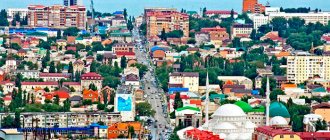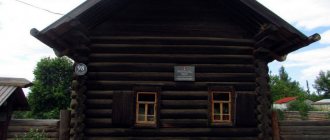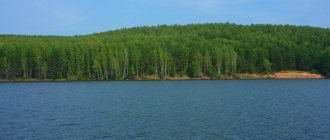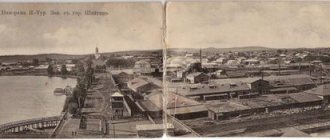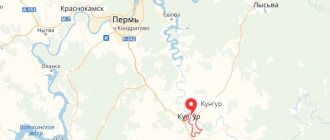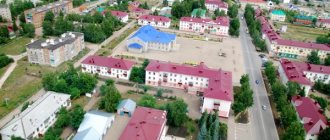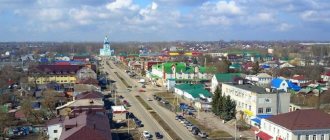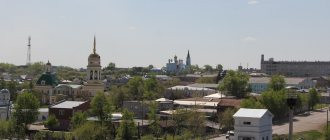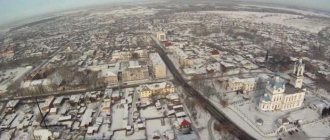Kozmodemyansk is a small ancient town on the left bank of the Volga, the administrative center of the Gornomarisky district of the Mari El Republic and the main cultural center of the mountain Mari. Kozmodemyansk is connected to the left bank of the republic by ferry.
The city is home to historical and cultural monuments of federal, republican and local significance, as well as museums. Every year the humorous festival “Benderiada” takes place here, named after the hero of the novels by Ilf and Petrov Ostap Bender. It will take 3-4 hours to see the main attractions of the city.
How to get there
- It is most convenient to visit Kozmodemyansk while traveling along the Volga - ships departing from Nizhny Novgorod and other cities stop here
- By bus: the city is located near the Republic of Chuvashia, buses run from Cheboksary to Kozmodemyansk, the travel time is about 1.5 hours
- By car, take the M-7 highway in the direction of Kazan. Pass the village of Vorotynets, Nizhny Novgorod region, then after about 60 km turn left to the village of Bolshoy Sundyr, then follow the sign to the right to Kozmodemyansk.
earth axis
But let's get back to our journey. On the site next to the monument, a pillar with many signs and a stone was also discovered that said that this was the “Axis of the Earth.”
Signpost
Stone "Axis of the Earth"
Next I quote the inscription from the stone: “For every person, the place where he was born, his father’s house, seems to be the center of the Universe. And the whole world revolves around him. For the Mountain Mari, this is a mountainous region, the land of Akpars.
This intersection is the geographical center of the Gornomari region. Its coordinates are 56°12'54''N. 45°33'17'' E If from this point we mentally pass the axis through the entire globe, then we will find ourselves in the endless expanses of the Pacific Ocean, where there is not a single island for the next 500 miles.
When going on a journey, touch this stone and wish yourself good luck on your journey to distant lands.
And the gravity of the mountainous land will help you return to your native land!”
Our dear friend began to desperately rub the stone, wishing himself more varied travels and, of course, good luck along the way.
The next discovery was a huge sundial, which did not show Moscow time at all.
The inscription on the clock read: “...to achieve accuracy of readings, the Gnomon (hand) is tilted strictly to the north at an angle equal to the latitude of the clock, in our case 56°12'54''N. Setting the clock is also very simple. When the sun is at its zenith, the shadow cast by the Gnomon shows true noon. The time shown by the sundial may not coincide with the accepted time, because... We do not live according to true time, which is different for each locality, but according to the accepted time for a certain part of the country. For our area, the difference between the true time and the accepted Moscow time is 90 minutes. 12 o'clock for our area corresponds to 13 hours 30 minutes Moscow time. 2013.”
Indeed, the clock showed approximately 15:50, and Moscow time was 16:50. “Half an hour was lost somewhere,” noted the Wild City Resident, although he vaguely realized that he was not at all an expert in deciphering sundials.
City `s history
According to legend, Ivan the Terrible, returning with his army after the conquest of Kazan, stopped for the night on the high bank of the Volga, from where a magnificent view of the Volga banks opened up. The king considered this place strategically advantageous and decided to found a fortified city here. Since this happened on the eve of the Day of the holy healers and miracle workers, the unmercenaries Kozma and Demyan, the city was named Kozmodemyansk.
But this is only a legend, and, according to historical facts, after the capture of Kazan in 1552, in order to avoid uprisings, fort towns began to be built in the Middle Volga region and in 1583 one of them, Kozmodemyansk, was founded. It should be noted that the holiday of Kozma and Demyan is celebrated on November 1, and in accordance with historical documents, Ivan the Terrible was already in Moscow on October 29.
At that time, the city was located on the Volga trade route, which was followed by ships from Persia and Central Asia to Nizhny Novgorod and Moscow. Also, the Siberian Highway, a road connecting Moscow with Siberia and China, passed through Kozmodemyansk. This favorable location of the city contributed to the development of trade and prosperity of the city. Residents of neighboring regions began to come here.
The population was engaged in fishing and hunting, beekeeping and crafts. The region was rich in dense forest, which during the time of Peter the Great was supplied for the construction of the Russian fleet.
In the 19th century, the city became the second center of timber trade in Russia after Arkhangelsk. Throughout the Volga region, the so-called “goat sticks” made of Karelian birch and wicker furniture made of bird cherry were famous. Sterlet was supplied to Moscow and St. Petersburg.
Since 1708, Kozmodemyansk was part of the Kazan province, from 1719 - part of the Sviyazhsk province, and from 1781 it was a district town of the Kazan governorship.
At the end of the 18th century, stone houses and churches began to be built in the city. In the second half of the 19th century, Kozmodemyansk became a prosperous city and even richer than neighboring Cheboksary and Tsarevokokshaysk - now Yoshkar-Ola. It would seem that the city was supposed to become the center of the Mari region, but all the new transport routes - both roads and railways - passed by the city, and the river communication ceased to be of strategic importance.
In 1920, the Mari Autonomous Region was formed, the capital of which was Tsarevokokshaysk, and Kozmodemyansk remained a regional center and a provincial town. During Soviet times, many architectural monuments of the city were destroyed.
Recent years have become a time of revival for Kozmodemyansk, churches are being restored and museums are being created.
Pepkinsky mound
Another attraction of this place was the Pepkinsky Kurgan - a unique monument of the Abashevo culture of the 2nd millennium BC. According to experts, this is a mass grave of male warriors who died as a result of a surprise attack. It is even possible that they all belonged to the same genus. The men were aged 18-25 years.
Path to the mound
Pepkinsky mound
The path to the mound and a view of the Akpars monument. The mound itself is behind
The mound itself is a ritual burial with a complex structure.
Mound
Temples
- Not far from the pier is the Streletskaya Chapel, built in 1697 in memory of the residents of the city who participated in Peter I’s campaign to Azov against the Crimean Khan. In the middle of the 20th century, the chapel's tent was destroyed, and a kerosene shop was placed inside it. In 2003, the Streletskaya Chapel was restored. The Chapel of the Savior of the Image Not Made by Hands is an architectural monument of the late 17th century
- Climbing Pugachevskaya Mountain you will see the Holy Trinity Church, built in 1733
- The most beautiful cathedral in Kozmodemyansk is the Smolensk Cathedral, built in 1871 in memory of the rescue of Emperor Alexander II during a failed attempt on his life by student Dmitry Karakozov. In its form and decorative decoration, the Smolensk Cathedral resembles the Cathedral of Christ the Savior in Moscow. Previously, the cathedral was famous for its bell tower with seven bells; the largest bell weighed 139 pounds (2 tons). The bell tower has not survived to this day.
Ferry
The wild city dweller had never been transported by ferry, and now he finally had the opportunity. He looked at this wide craft with interest, imagining how he would now rush on it with full sails... And all around was the smooth surface of the Volga River, which spilled for many kilometers around. The views are truly beautiful.
The ferry leaves from here
Volga River and queue for the ferry
The cost of the crossing as of 2015 is 300 rubles per car + 31 rubles per person. It takes about half an hour to swim to the other side, but they fly by extremely quickly and unnoticed. We set sail from shore at about 5:30 p.m.
The ferry docks at the pier
On a ferryboat
During the trip, nature surprised us with another miracle. Sailing from the shores of Kozmodemyansk, a wild city dweller noticed a rainbow. The strange thing was that there was no rain. A rainbow appeared just like that, in the rays of the setting sun against the background of bluish clouds. And seagulls hovered around, begging for treats. Our hero, rejoicing like a child, threw them pieces of half-eaten bread; the birds caught them in flight, simultaneously fighting among themselves for the precious crumbs.
View of Kozmodemyansk from the ferryWater, rainbows, birds and an amazing feeling of fullness of life!
And here is the other bank near the village of Korotni . Another information board was discovered there, stating that this place had been inhabited since the 5th century BC, as evidenced by archaeological finds.
And then – 130 km to Svetloyar. And we can say with confidence that the trip was a success!
Map from the M7 highway to Kozmodemyansk:
Full route:
0
What to see
Museum of Satire and Humor in Kozmodemyansk
Kozmodemyansk became the prototype of the city of Vasyuki - according to legend, the famous chess club was founded here by the son of a Turkish citizen, Ostap Bender. True, this fact is disputed by residents of the city of Vasilsursk, who believe that it is their city located upstream that is described in the novel “The Twelve Chairs”.
One of the main attractions of Kozmodemyansk is the Ostap Bender Museum of Satire and Humor, famous throughout the country. It is believed that it was in this building that the famous chess tournament was held.
The museum organizes excursions, and individual tourists will be able to view the exhibitions on their own. For those who want to remember the novel, you can watch footage from the film “The Twelve Chairs” with Sergei Yursky in the title role.
On Chernyshevsky Street, not far from the Streletskaya Tower, a monument to twelve chairs was erected, and the romance of Ilf and Petrov became part of the life of the city residents.
Festival "Benderiada"
Since 1995, every summer, at the height of the tourist season, a humorous festival named after Ostap Bender, “Benderiada,” is held in Kozmodemyansk. At this time, numerous fans of the works of Ilf and Petrov arrive here. The city is filled with joy and fun, concerts and carnivals are held here, auctions and quizzes, chess tournaments and other events are organized.
These days, “great schemers” walk through the streets, each wearing a checkered jacket, scarf and captain’s cap, and everyone can take part in a simultaneous chess game and an auction for the sale of chairs.
Center of Mountain Mari Culture
Kozmodemyansk is famous for its folk crafts, including colorful embroidery and skillful wickerwork. Wood carving is especially noteworthy: almost every village house is decorated with beautiful platbands.
In Kozmodemyansk, on Sovetskaya Street, house No. 8, there is a building built at the beginning of the 20th century and recognized for its platbands as the most beautiful house in the Volga region, this is the House of the Tradesman Suryaninov.
Grigoriev Art and Historical Museum
Not far from the pier there is the former mansion of the merchant Ponomarev, which houses the Grigoriev Art and Historical Museum.
The founder of the museum, Alexander Grigoriev, called his brainchild the Small Tretyakov Gallery. The exhibition features unique collections of porcelain and ceramics, as well as works by famous artists, including works by Aivazovsky and Levitan, Kramskoy and Polenov.
The history of this collection is interesting. The works of famous painting masters were exhibited in Kozmodemyansk as part of a traveling exhibition during the turbulent years of the civil war and have remained in the city since then.
Ethnographical museum
The open-air ethnographic museum is located on the high bank of the Volga, from which a magnificent view of the river and the old city opens. The museum is presented in the form of a small village where you can get acquainted with the life and culture of the Mari people. Here are buildings moved in 1983 from the flood zone of the Cheboksary reservoir.
Among the exhibits are a working tented windmill, a blacksmith shop and a residential hut, barns and baths. Tourists can get acquainted with folk crafts, including Mountain Mari embroidery.
Monument to Akpars
There are also “serious” monuments in Kozmodemyansk, and one of them was erected in honor of the national hero of the Mari people, Prince Akpars, a contemporary of Ivan the Terrible.
Local princes were always together with the Russian people in the fight against the Kazan Khanate. According to legend, Prince Akpars, playing the harp, quietly measured with steps the distance to which it was necessary to dig a ditch necessary to undermine the fortress wall. So his cunning and courage helped to capture Kazan, and the name of Prince Akpars went down in history forever. In honor of the hero, a monument to Apraks was erected in the city, next to the pier.
It can be noted that Kozmodemyansk is a city of three eras. On the one hand, high-rise buildings, schools and shops are built in it; modern people live here. But there are two more eras in the city:
- The time of the 20–30s of the XX century, described in the fascinating novel “The Twelve Chairs”
- The spirit of the 19th century, inspired by quiet old streets and houses with lace carvings.
Kozmodemyansk is an amazing city that can charm any tourist. Many of the guests come here again and again to admire the views of the Volga and ancient houses, visit the Benderiad and chat with the friendly residents of the city.
A little about Akpars
Akpars was born at the end of the 15th - beginning of the 16th century in the village of Nuzhenaly, Mountain Mari region, and was the hundredth prince of the Mountain Mari. He proved himself to be a far-sighted politician and diplomat during the Moscow-Kazan confrontation. He advocated voluntary accession to the Russian state.
His name was given to the lands that in the 16th-18th centuries occupied a significant part of the modern Gornomariysky region on both banks of the Volga - Akparsova hundred.
I will give some legends about Akpars.
The legend of the capture of Kazan
“The Russians have been fighting for Kazan for a long time, but they cannot take it. Then Akpars suggested setting up a tunnel and blowing up the fortress. Playing the harp, he approaches the fortress and finds out the distance to the wall. Then he sets up a tunnel, where they roll in powder barrels and place candles on them. A candle was also placed at the entrance to the tunnel. It has already burned out, but there is no explosion. Ivan the Terrible accuses Akpars of treason, is going to execute him, he explains to the tsar the reason for the delay in the explosion. The wall is destroyed, Kazan is taken. Akpars received a royal letter, which said: “The Mari should not be oppressed, the boyars and governors should not be given away, they should not be attached, but they should live freely on their own land and pay only a certain tribute for each Mari hunter who has come of age. But this certificate disappeared."
Hence the symbolism of the monument - Akpars is depicted with a harp, as a symbol of the spiritual greatness of the idea of unity on the basis of harmony and friendship of the peoples of Russia.
“Some facts related to the personality of Akpars are worthy of mention. In particular, legends have been preserved that Tsar Ivan IV stayed for three days in his ancestral village of Nuzhenaly and hunted in the local oak forests, and “for the happy outcome of the war, which began through the excitement of the Cheremis intercessors,” he presented Akpars with a gold (silver?) cup with the image King Solomon (according to other sources - an eagle) stallion, an expensive saddle and a saber.” “The Mari legend about Akpars.” (From the history of the conquest of Kazan by Ivan the Terrible) // Scientific notes of MarNII. Yoshkar-Ola, 1955, issue. 7.
The image on the monument of Ivan the Terrible and Akpars shaking hands
Several literary, musical and artistic works have been written in honor of this national hero. The district cinema and some other organizations are named after him.
Even the motto of the Mountain Mari region sounds like this: “Let us glorify the land of Akpars!”



